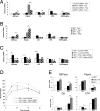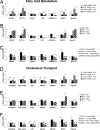Fasting-dependent glucose and lipid metabolic response through hepatic sirtuin 1
- PMID: 17646659
- PMCID: PMC1937557
- DOI: 10.1073/pnas.0702509104
Fasting-dependent glucose and lipid metabolic response through hepatic sirtuin 1
Abstract
In the fasted state, induction of hepatic glucose output and fatty acid oxidation is essential to sustain energetic balance. Production and oxidation of glucose and fatty acids by the liver are controlled through a complex network of transcriptional regulators. Among them, the transcriptional coactivator PGC-1alpha plays an important role in hepatic and systemic glucose and lipid metabolism. We have previously demonstrated that sirtuin 1 (SIRT1) regulates genes involved in gluconeogenesis through interaction and deacetylation of PGC-1alpha. Here, we show in vivo that hepatic SIRT1 is a factor in systemic and hepatic glucose, lipid, and cholesterol homeostasis. Knockdown of SIRT1 in liver caused mild hypoglycemia, increased systemic glucose and insulin sensitivity, and decreased glucose production. SIRT1 knockdown also decreased serum cholesterol and increased hepatic free fatty acid and cholesterol content. These metabolic phenotypes caused by SIRT1 knockdown tightly correlated with decreased expression of gluconeogenic, fatty acid oxidation and cholesterol degradation as well as efflux genes. Additionally, overexpression of SIRT1 reversed many of the changes caused by SIRT1 knockdown and depended on the presence of PGC-1alpha. Interestingly, most of the effects of SIRT1 were only apparent in the fasted state. Our results indicate that hepatic SIRT1 is an important factor in the regulation of glucose and lipid metabolism in response to nutrient deprivation. As these pathways are dysregulated in metabolic diseases, SIRT1 may be a potential therapeutic target to control hyperglycemia and hypercholesterolemia.
Conflict of interest statement
The authors declare no conflict of interest.
Figures




References
-
- Rutter GA. Curr Biol. 2000;10:R736–738. - PubMed
-
- Michael MD, Kulkarni RN, Postic C, Previs SF, Shulman GI, Magnuson MA, Kahn CR. Mol Cell. 2000;6:87–97. - PubMed
-
- Muoio DM, Newgard CB. Annu Rev Biochem. 2006;75:367–401. - PubMed
-
- Pilkis SJ, Granner DK. Annu Rev Physiol. 1992;54:885–909. - PubMed
-
- Owen OE, Kalhan SC, Hanson RW. J Biol Chem. 2002;277:30409–30412. - PubMed
Publication types
MeSH terms
Substances
Grants and funding
LinkOut - more resources
Full Text Sources
Other Literature Sources
Research Materials

